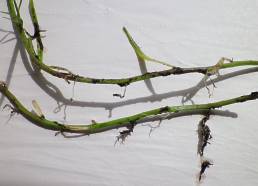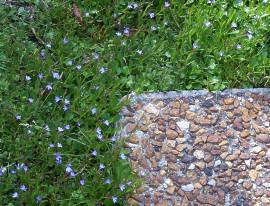Lobelia anceps
Lobelia anceps L.f.
Family: Lobeliaceae
Common names: angled lobelia, swamp lobelia
Introduction
If you are looking for an attractive groundcover for a wet or boggy area, the swamp lobelia could be the perfect plant for you!

Description
Description
Lobelia anceps is a variable sprawling herbaceous perennial groundcover with prostrate branches that root at the nodes. Some of the branches become erect and may reach a height of 450 mm or even taller if growing up through other vegetation. Erect stems have 3 very narrow wings along their length while the prostrate ones only have 2. Plants may be smooth or softly hairy. The soft, toothed leaves are narrow to spoon-shaped and broader towards the base. They range from 1-5 mm wide and 20-100 mm long. The little flowers may be white or varying shades of blue or mauve. They occur in the axils of the upper leaves. The corolla tube is split to the base between the upper 2 petals which are tiny and stand upright while the lower 3 are much larger, forming a fan shape. The stamens are shorter than the corolla tube and the lower 2 anthers have a brush-like tuft of white hairs at their tips. It flowers from November to June. The fruit is a capsule containing a number of small seeds. This is a fast growing species especially in warm, damp conditions.


Conservation Status
Status
As this plant is common, it is listed as Least Concern in the latest South African Red List (Raimondo et al. 2009).
Distribution and habitat
Distribution description
This is a very widespread species, not only in southern Africa but it occurs in New Zealand and Australia as well. It has become naturalized in Brazil. In Southern Africa it is frequently encountered in damp conditions close to the coast in the southwestern, southern and eastern areas, although it also occurs inland in suitably damp habitats.
Derivation of name and historical aspects
History
The genus name Lobelia commemorates Matthias de l'Obel, a Flemish nobleman who was a botanist and physician to James I of England. He lived from 1538-1616. The specific name anceps is derived from a word meaning two-edged; flattened; as of a flattened two-edged stem. Lobelia anceps is still sometimes known by its synonym of Lobelia alata. "Alatus" is the Latin word for "winged" and therefore both these specific names refer to the narrow expansion or 'wing' along the length of the stems.
There are about 300 species of Lobelia which occur across the world.
It was collected by Joseph Banks in New Zealand in October 1769. In some publications it may be found under the family Campanulaceae.
Ecology
Ecology
Bees have been seen visiting the flowers and are presumably the pollinators of this species.
Uses
Use
Although not very large, this plant has value as an horticultural subject in wet or damp areas as a ground cover.

Growing Lobelia anceps
Grow
As this lobelia grows so easily from cuttings we, in the Harold Porter National Botanical Garden do not bother to attempt to grow it from seed which is very small and not easily gathered. Cuttings can be made almost all year round except for the coldest months and will readily root in a mixture of 50% well rotted finely sieved pine bark and 50% polystyrene granules (by volume) which is kept constantly damp. The cut surfaces of the plant exude a milky sap which must be allowed to dry out for at least ten minutes before dipping into a rooting hormone powder for soft cuttings. The trays of cuttings are sprayed with a fungicide before being placed in the misthouse. Rooting occurs within 2-3 weeks and the cuttings can then be planted directly into position if the area remains damp, or they may be potted up into a mixture of 10 parts of clean river sand, 6 parts of loam soil and 15 parts of organic compost. Plants can be fed with a liquid fertilizer.
Lobelia anceps makes a wonderful display around stepping stones or flagstones, or round ponds or in boggy areas, especially when combined with Monopsis lutea, the yellow lobelia, another damp-loving groundcover, as the combination of blue and yellow flowers is most attractive. Lobelia anceps may even grow out from the soil banks of a still or slow-moving water body to form a mat on the water surface.
References
- Adamson, R.S. & Salter, T.M. (eds). 1950. Flora of the Cape Peninsula. Juta, Cape Town.
- Bean, A. & Johns, A. 2005. Stellenbosch to Hermanus. South African Wildflower Guide 5. Botanical Society of South Africa, Cape Town.
- Bohnen, P. 1986. Flowering plants of the southern Cape. The Still Bay Trust. Still Bay.
- Dyer, R.A. 1975. The genera of southern African flowering plants, vol. 1, Dicotyledons. Botanical Research Institute, Pretoria.
- Goldblatt, P. & Manning, J. 2000. Cape Plants, A conspectus of the Cape Flora of South Africa. Strelitzia 9, National Botanical Institute, Pretoriaand Missouri Botanical Garden Press.
- Kesting, D. (compiler). 2001. Wild flowers of the Cape Peninsula. Botanical names: Origin and meaning. Flora Documentation Project, Friends of the Silvermine Nature Area, St James.
- Leistner, O.A. (ed.). 2000. Seeds plants of southern Africa: families and genera. Strelitzia 10. National Botanical Institute, Pretoria.
- Manning, J. 2001. Eastern Cape. South African Wild Flower Guide 11. The Botanical Society of South Africa, Cape Town.
- Maytham Kidd, M. [Author: what is the date of the copy used?] Cape Peninsula. South African Wild Flower Guide 3, edn 4. Botanical Society of South Africa, Cape Town.
- Raimondo, D., Von Staden, L., Foden, W., Victor, J.E., Helme, N.A., Turner, R.C., Kamundi, D.A. & Manyama, P.A. (eds) 2009. Red List of South African plants 2009, Strelitzia 25. South African National Biodiversity Institute, Pretoria.
Credits
Jane Forrester
Harold Porter National Botanical Garden
May 2011
Plant Attributes:
Plant Type: Ground Cover
SA Distribution: Eastern Cape, KwaZulu-Natal, Western Cape
Soil type: Sandy, Loam
Flowering season: Early Summer, Late Summer, Autumn, Winter
PH: Acid
Flower colour: Blue
Aspect: Full Sun, Shade, Morning Sun (Semi Shade), Afternoon Sun (Semi Shade)
Gardening skill: Easy
Special Features:
Horticultural zones








Rate this article
Article well written and informative
Rate this plant
Is this an interesting plant?
Login to add your Comment
Back to topNot registered yet? Click here to register.